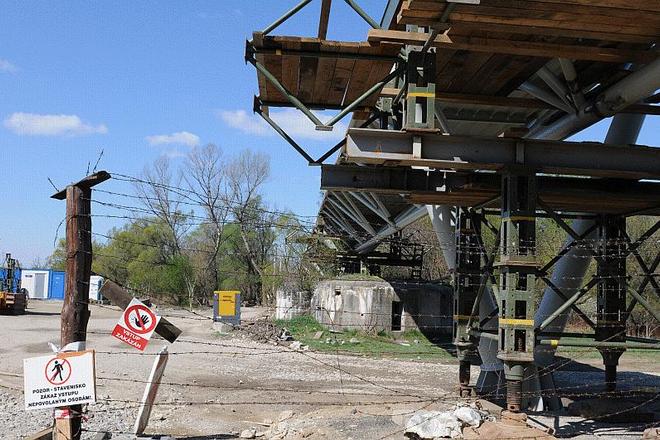HISTORY is already heaped high at this site. The light steel structure of a new bridge joining Austria with Slovakia now arches over the remains of a bridge from the era of Empress Maria Theresa. At its base is an intact bunker from the inter-war period and the construction site is partly hemmed in by the remains of the Iron Curtain. But its barbed wires today serve only to support a sign warning that this is the construction site of a cycling bridge connecting Slovakia’s Devínska Nová Ves and Austria’s Schloss Hof.
Construction of the bridge is a joint project by the Bratislava Region government and Niederösterreich, the State of Lower Austria. It will primarily serve cyclists and pedestrians and, if necessary, emergency vehicles. It should open to the public as early as this summer.
The bridge spans the Morava River at the exact spot where a bridge used to stand that once brought Empress Maria Theresa, when she was in residence at the Schloss Hof estate, closer to her beloved daughter Maria-Christina, who lived with her husband, Albert of Saxony, in Bratislava, or Pressburg as it was then known.
“The bridge from Devínska Nová Ves to Schloss Hof is almost finished,” Pavol Frešo, the head of the Bratislava Regional Government said on April 18, during a visit to the construction site. “Not only for me, but also for others who waited almost 70 years for the Morava River to again be bridged in Bratislava Region, it is one of our dreams fulfilled.”
Erwin Pröll, the governor of Lower Austria, and Frešo, his Slovak counterpart, believe the bridge will intensify cross-border tourism and bring more convenience to visitors.
For Pröll, the bridge is “a symbol of cooperation and a great opportunity for cycling tourism in two highly dynamic regions”, adding it “signals our entry into an era determined not to tear down bridges but to build new ones”.
According to Pröll, “this bridge bears witness to the fact that here, at this interface between the old and the new Europe, our regions are finally converging.”
The Bratislava Region government expects the bridge, which will connect cycling routes on both sides of the river, to improve the opportunities for leisure activities for tourists and residents on both sides of the river, including users of the Iron Curtain Trail, Iveta Tyšlerová, spokesperson for the Bratislava Regional Government told The Slovak Spectator.
The cost of construction, excluding the access road on the Austrian side (which includes the reconstruction of historical parts of the bridge) tops €3.1 million. Slovakia will cover €2 million of this and Austria will contribute the remaining €1.1 million, according to Tyšlerová.
The steel bridge structure makes up 525 metres of the entire 955-metre length of the project.
An official opening ceremony under the auspices of the Austrian regional government is planned for September 22.
When the bridge is open it will take only minutes to walk from Devínska Nová Ves to the lower part of the gardens of Schloss Hof, a reconstructed Baroque palace and estate.
Schloss Hof is only one of several popular tourist attractions just across the border. Others include the Donau-Auen National Park and the Carnuntum Archaeological Park plus other Roman-era archaeological sites. The latter was part of the Lower Austrian Provincial Exhibition of 2011, and provided a special impetus for cross-border cooperation. The exhibition at and around Carnuntum, a former Roman settlement, attracted 554,438 visitors, 10 percent of whom came from Slovakia.
Schloss Hof, the Donau-Auen National Park and the Carnuntum Archaeological Park in recent years have offered Slovak-language tours and discounted entry to Slovaks during public holidays in Slovakia.



 Some remains from the Iron Curtain, overshadowed by the new bridge. (source: Jana Liptáková)
Some remains from the Iron Curtain, overshadowed by the new bridge. (source: Jana Liptáková)